Managerial Accounting Assignment: Keep or Buy, Special Order, Make/Buy
VerifiedAdded on 2022/12/22
|7
|1943
|29
Homework Assignment
AI Summary
This document provides a comprehensive solution to a managerial accounting assignment, addressing three key decision-making scenarios: keep or buy, special order, and make or buy. The keep or buy decision analyzes the costs of restoring an old motorcycle versus purchasing a new one, concluding that buying is more cost-effective. The special order decision assesses whether a company should accept a special order, considering both quantitative and qualitative factors like incremental profit and the impact on regular sales. Finally, the make or buy decision compares the costs of in-house production of implants with purchasing them from an external source, recommending the latter. The document includes detailed cost analyses, working notes, and discussions of relevant qualitative factors, such as sunk costs, supplier reliability, and long-term strategic considerations.
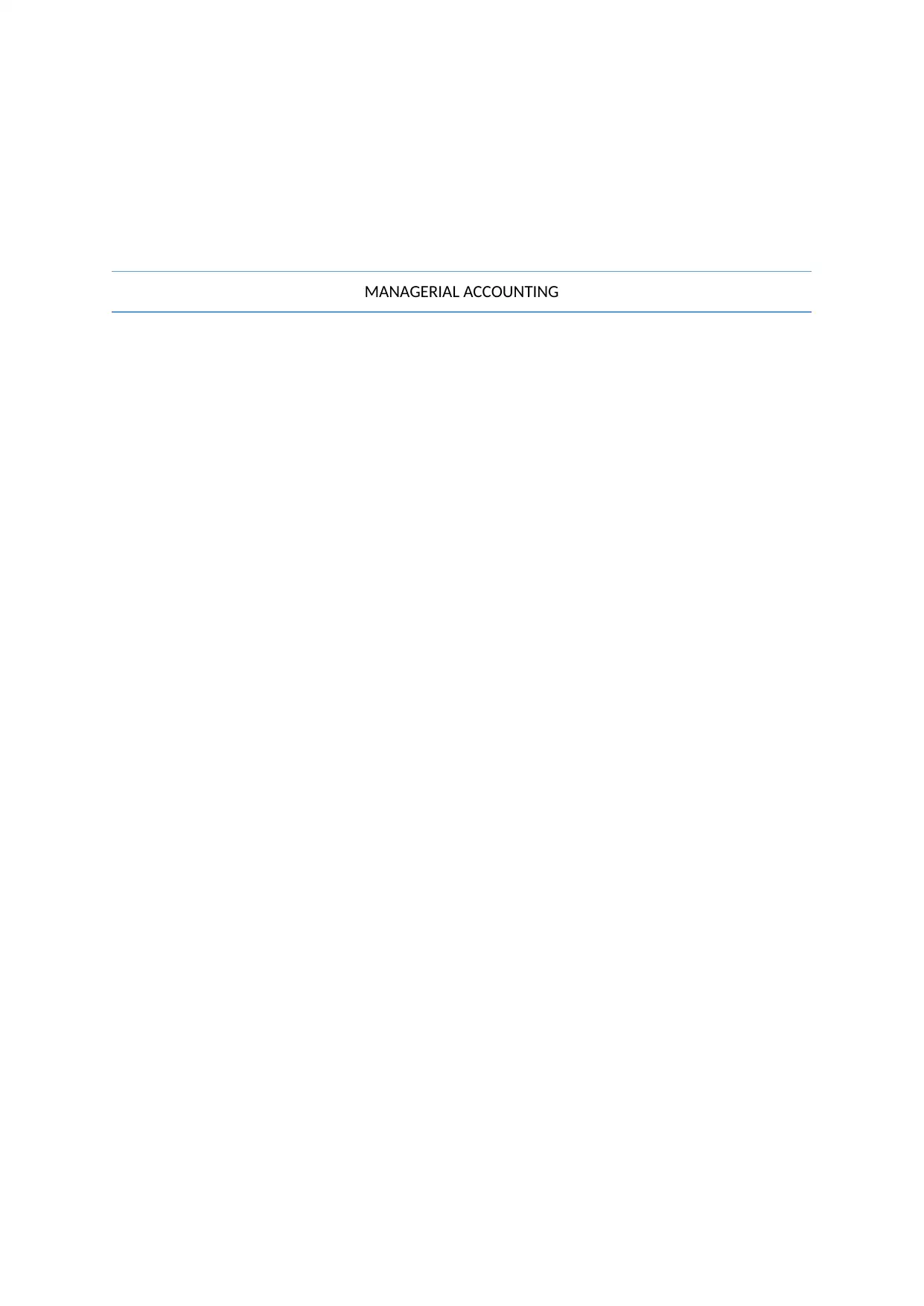
MANAGERIAL ACCOUNTING
Paraphrase This Document
Need a fresh take? Get an instant paraphrase of this document with our AI Paraphraser
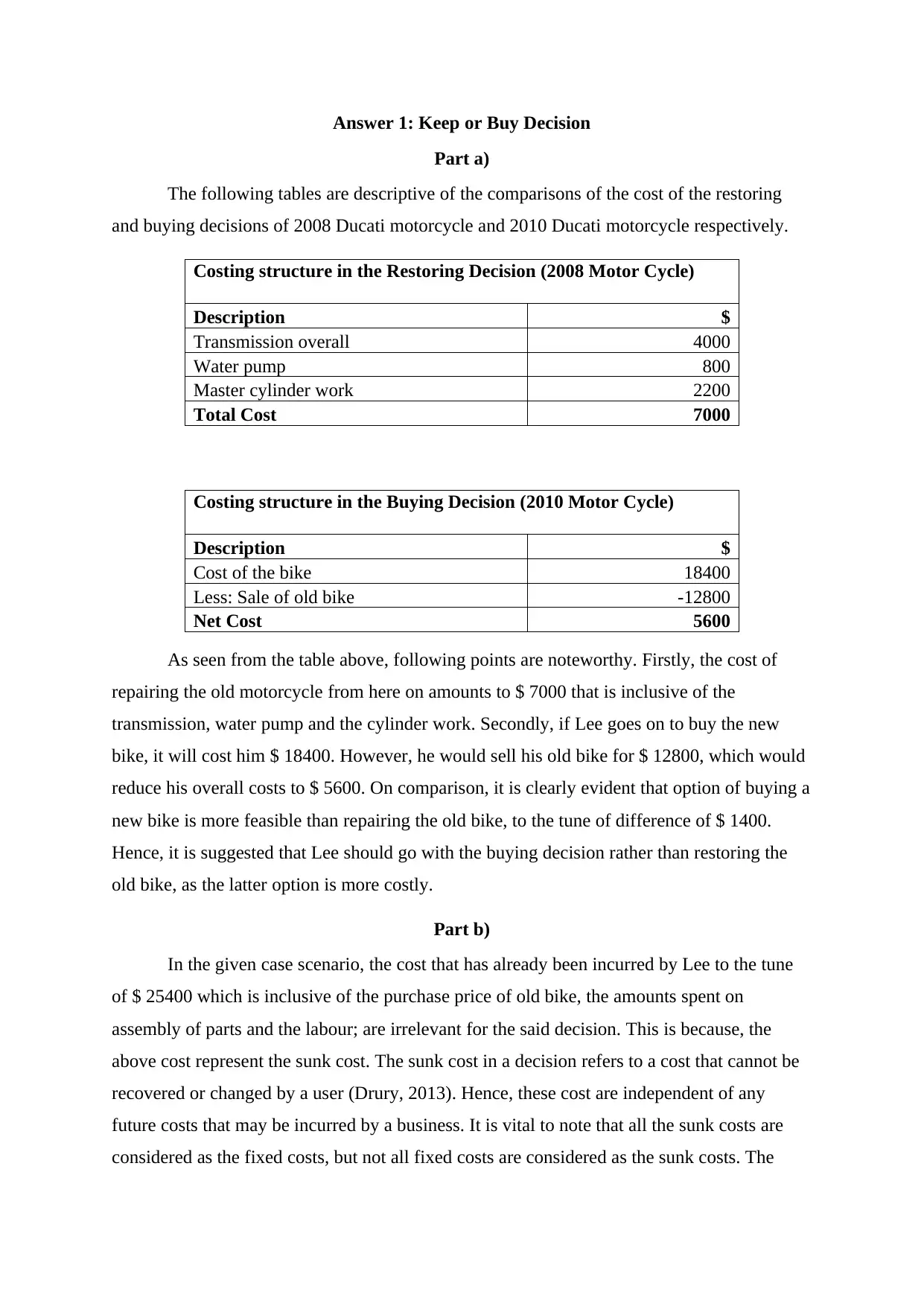
Answer 1: Keep or Buy Decision
Part a)
The following tables are descriptive of the comparisons of the cost of the restoring
and buying decisions of 2008 Ducati motorcycle and 2010 Ducati motorcycle respectively.
Costing structure in the Restoring Decision (2008 Motor Cycle)
Description $
Transmission overall 4000
Water pump 800
Master cylinder work 2200
Total Cost 7000
As seen from the table above, following points are noteworthy. Firstly, the cost of
repairing the old motorcycle from here on amounts to $ 7000 that is inclusive of the
transmission, water pump and the cylinder work. Secondly, if Lee goes on to buy the new
bike, it will cost him $ 18400. However, he would sell his old bike for $ 12800, which would
reduce his overall costs to $ 5600. On comparison, it is clearly evident that option of buying a
new bike is more feasible than repairing the old bike, to the tune of difference of $ 1400.
Hence, it is suggested that Lee should go with the buying decision rather than restoring the
old bike, as the latter option is more costly.
Part b)
In the given case scenario, the cost that has already been incurred by Lee to the tune
of $ 25400 which is inclusive of the purchase price of old bike, the amounts spent on
assembly of parts and the labour; are irrelevant for the said decision. This is because, the
above cost represent the sunk cost. The sunk cost in a decision refers to a cost that cannot be
recovered or changed by a user (Drury, 2013). Hence, these cost are independent of any
future costs that may be incurred by a business. It is vital to note that all the sunk costs are
considered as the fixed costs, but not all fixed costs are considered as the sunk costs. The
Costing structure in the Buying Decision (2010 Motor Cycle)
Description $
Cost of the bike 18400
Less: Sale of old bike -12800
Net Cost 5600
Part a)
The following tables are descriptive of the comparisons of the cost of the restoring
and buying decisions of 2008 Ducati motorcycle and 2010 Ducati motorcycle respectively.
Costing structure in the Restoring Decision (2008 Motor Cycle)
Description $
Transmission overall 4000
Water pump 800
Master cylinder work 2200
Total Cost 7000
As seen from the table above, following points are noteworthy. Firstly, the cost of
repairing the old motorcycle from here on amounts to $ 7000 that is inclusive of the
transmission, water pump and the cylinder work. Secondly, if Lee goes on to buy the new
bike, it will cost him $ 18400. However, he would sell his old bike for $ 12800, which would
reduce his overall costs to $ 5600. On comparison, it is clearly evident that option of buying a
new bike is more feasible than repairing the old bike, to the tune of difference of $ 1400.
Hence, it is suggested that Lee should go with the buying decision rather than restoring the
old bike, as the latter option is more costly.
Part b)
In the given case scenario, the cost that has already been incurred by Lee to the tune
of $ 25400 which is inclusive of the purchase price of old bike, the amounts spent on
assembly of parts and the labour; are irrelevant for the said decision. This is because, the
above cost represent the sunk cost. The sunk cost in a decision refers to a cost that cannot be
recovered or changed by a user (Drury, 2013). Hence, these cost are independent of any
future costs that may be incurred by a business. It is vital to note that all the sunk costs are
considered as the fixed costs, but not all fixed costs are considered as the sunk costs. The
Costing structure in the Buying Decision (2010 Motor Cycle)
Description $
Cost of the bike 18400
Less: Sale of old bike -12800
Net Cost 5600
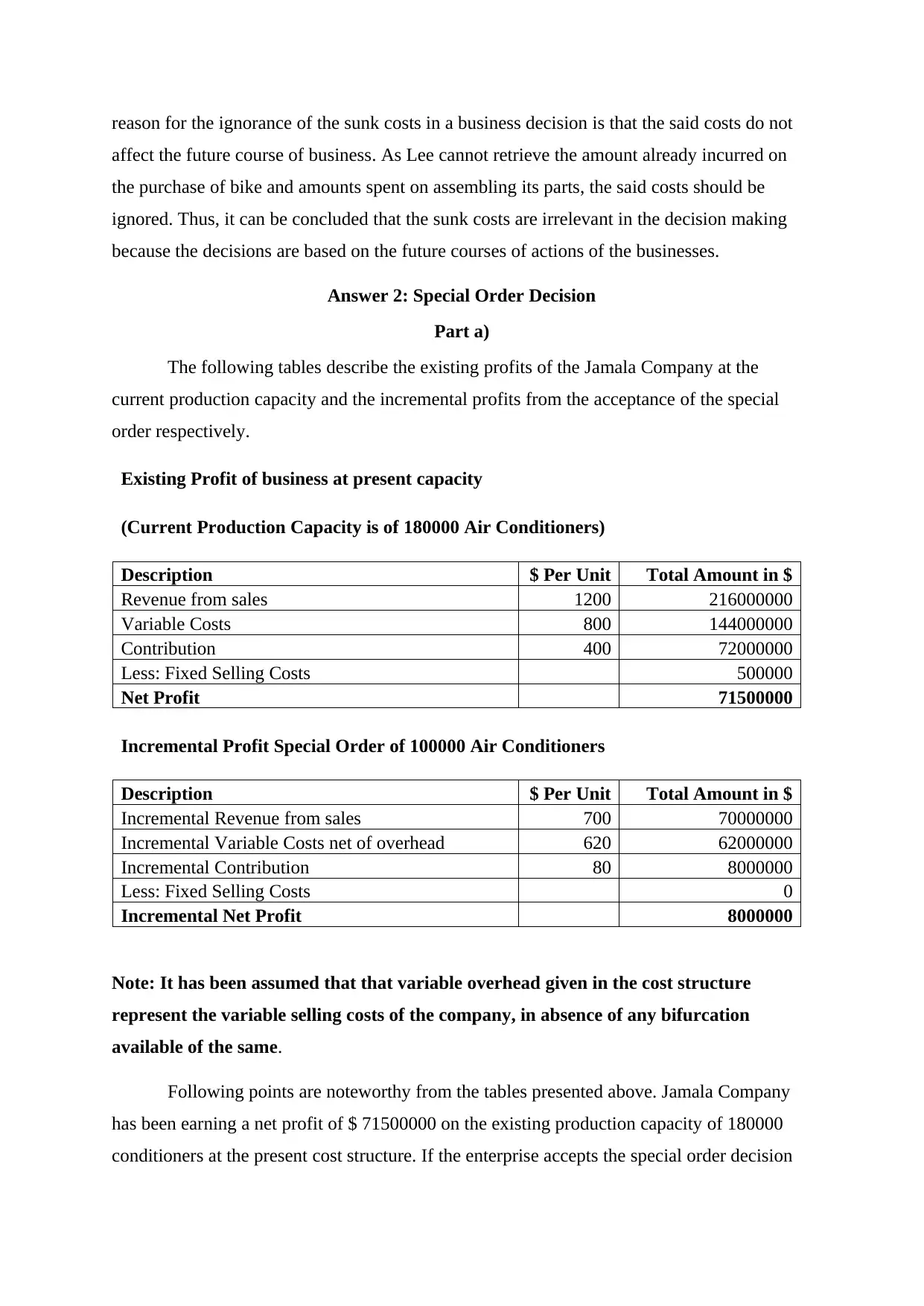
reason for the ignorance of the sunk costs in a business decision is that the said costs do not
affect the future course of business. As Lee cannot retrieve the amount already incurred on
the purchase of bike and amounts spent on assembling its parts, the said costs should be
ignored. Thus, it can be concluded that the sunk costs are irrelevant in the decision making
because the decisions are based on the future courses of actions of the businesses.
Answer 2: Special Order Decision
Part a)
The following tables describe the existing profits of the Jamala Company at the
current production capacity and the incremental profits from the acceptance of the special
order respectively.
Existing Profit of business at present capacity
(Current Production Capacity is of 180000 Air Conditioners)
Description $ Per Unit Total Amount in $
Revenue from sales 1200 216000000
Variable Costs 800 144000000
Contribution 400 72000000
Less: Fixed Selling Costs 500000
Net Profit 71500000
Incremental Profit Special Order of 100000 Air Conditioners
Description $ Per Unit Total Amount in $
Incremental Revenue from sales 700 70000000
Incremental Variable Costs net of overhead 620 62000000
Incremental Contribution 80 8000000
Less: Fixed Selling Costs 0
Incremental Net Profit 8000000
Note: It has been assumed that that variable overhead given in the cost structure
represent the variable selling costs of the company, in absence of any bifurcation
available of the same.
Following points are noteworthy from the tables presented above. Jamala Company
has been earning a net profit of $ 71500000 on the existing production capacity of 180000
conditioners at the present cost structure. If the enterprise accepts the special order decision
affect the future course of business. As Lee cannot retrieve the amount already incurred on
the purchase of bike and amounts spent on assembling its parts, the said costs should be
ignored. Thus, it can be concluded that the sunk costs are irrelevant in the decision making
because the decisions are based on the future courses of actions of the businesses.
Answer 2: Special Order Decision
Part a)
The following tables describe the existing profits of the Jamala Company at the
current production capacity and the incremental profits from the acceptance of the special
order respectively.
Existing Profit of business at present capacity
(Current Production Capacity is of 180000 Air Conditioners)
Description $ Per Unit Total Amount in $
Revenue from sales 1200 216000000
Variable Costs 800 144000000
Contribution 400 72000000
Less: Fixed Selling Costs 500000
Net Profit 71500000
Incremental Profit Special Order of 100000 Air Conditioners
Description $ Per Unit Total Amount in $
Incremental Revenue from sales 700 70000000
Incremental Variable Costs net of overhead 620 62000000
Incremental Contribution 80 8000000
Less: Fixed Selling Costs 0
Incremental Net Profit 8000000
Note: It has been assumed that that variable overhead given in the cost structure
represent the variable selling costs of the company, in absence of any bifurcation
available of the same.
Following points are noteworthy from the tables presented above. Jamala Company
has been earning a net profit of $ 71500000 on the existing production capacity of 180000
conditioners at the present cost structure. If the enterprise accepts the special order decision
⊘ This is a preview!⊘
Do you want full access?
Subscribe today to unlock all pages.

Trusted by 1+ million students worldwide
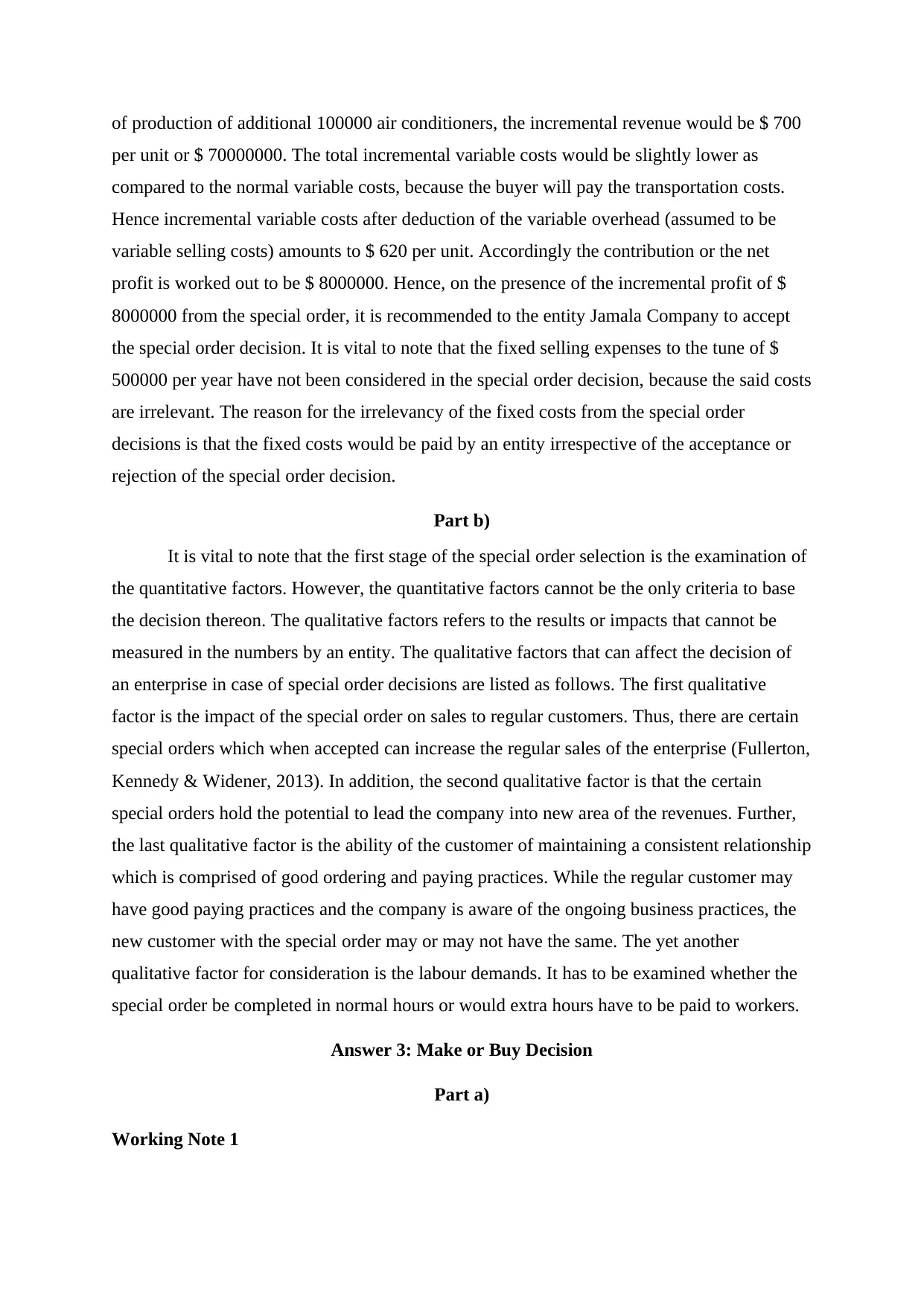
of production of additional 100000 air conditioners, the incremental revenue would be $ 700
per unit or $ 70000000. The total incremental variable costs would be slightly lower as
compared to the normal variable costs, because the buyer will pay the transportation costs.
Hence incremental variable costs after deduction of the variable overhead (assumed to be
variable selling costs) amounts to $ 620 per unit. Accordingly the contribution or the net
profit is worked out to be $ 8000000. Hence, on the presence of the incremental profit of $
8000000 from the special order, it is recommended to the entity Jamala Company to accept
the special order decision. It is vital to note that the fixed selling expenses to the tune of $
500000 per year have not been considered in the special order decision, because the said costs
are irrelevant. The reason for the irrelevancy of the fixed costs from the special order
decisions is that the fixed costs would be paid by an entity irrespective of the acceptance or
rejection of the special order decision.
Part b)
It is vital to note that the first stage of the special order selection is the examination of
the quantitative factors. However, the quantitative factors cannot be the only criteria to base
the decision thereon. The qualitative factors refers to the results or impacts that cannot be
measured in the numbers by an entity. The qualitative factors that can affect the decision of
an enterprise in case of special order decisions are listed as follows. The first qualitative
factor is the impact of the special order on sales to regular customers. Thus, there are certain
special orders which when accepted can increase the regular sales of the enterprise (Fullerton,
Kennedy & Widener, 2013). In addition, the second qualitative factor is that the certain
special orders hold the potential to lead the company into new area of the revenues. Further,
the last qualitative factor is the ability of the customer of maintaining a consistent relationship
which is comprised of good ordering and paying practices. While the regular customer may
have good paying practices and the company is aware of the ongoing business practices, the
new customer with the special order may or may not have the same. The yet another
qualitative factor for consideration is the labour demands. It has to be examined whether the
special order be completed in normal hours or would extra hours have to be paid to workers.
Answer 3: Make or Buy Decision
Part a)
Working Note 1
per unit or $ 70000000. The total incremental variable costs would be slightly lower as
compared to the normal variable costs, because the buyer will pay the transportation costs.
Hence incremental variable costs after deduction of the variable overhead (assumed to be
variable selling costs) amounts to $ 620 per unit. Accordingly the contribution or the net
profit is worked out to be $ 8000000. Hence, on the presence of the incremental profit of $
8000000 from the special order, it is recommended to the entity Jamala Company to accept
the special order decision. It is vital to note that the fixed selling expenses to the tune of $
500000 per year have not been considered in the special order decision, because the said costs
are irrelevant. The reason for the irrelevancy of the fixed costs from the special order
decisions is that the fixed costs would be paid by an entity irrespective of the acceptance or
rejection of the special order decision.
Part b)
It is vital to note that the first stage of the special order selection is the examination of
the quantitative factors. However, the quantitative factors cannot be the only criteria to base
the decision thereon. The qualitative factors refers to the results or impacts that cannot be
measured in the numbers by an entity. The qualitative factors that can affect the decision of
an enterprise in case of special order decisions are listed as follows. The first qualitative
factor is the impact of the special order on sales to regular customers. Thus, there are certain
special orders which when accepted can increase the regular sales of the enterprise (Fullerton,
Kennedy & Widener, 2013). In addition, the second qualitative factor is that the certain
special orders hold the potential to lead the company into new area of the revenues. Further,
the last qualitative factor is the ability of the customer of maintaining a consistent relationship
which is comprised of good ordering and paying practices. While the regular customer may
have good paying practices and the company is aware of the ongoing business practices, the
new customer with the special order may or may not have the same. The yet another
qualitative factor for consideration is the labour demands. It has to be examined whether the
special order be completed in normal hours or would extra hours have to be paid to workers.
Answer 3: Make or Buy Decision
Part a)
Working Note 1
Paraphrase This Document
Need a fresh take? Get an instant paraphrase of this document with our AI Paraphraser
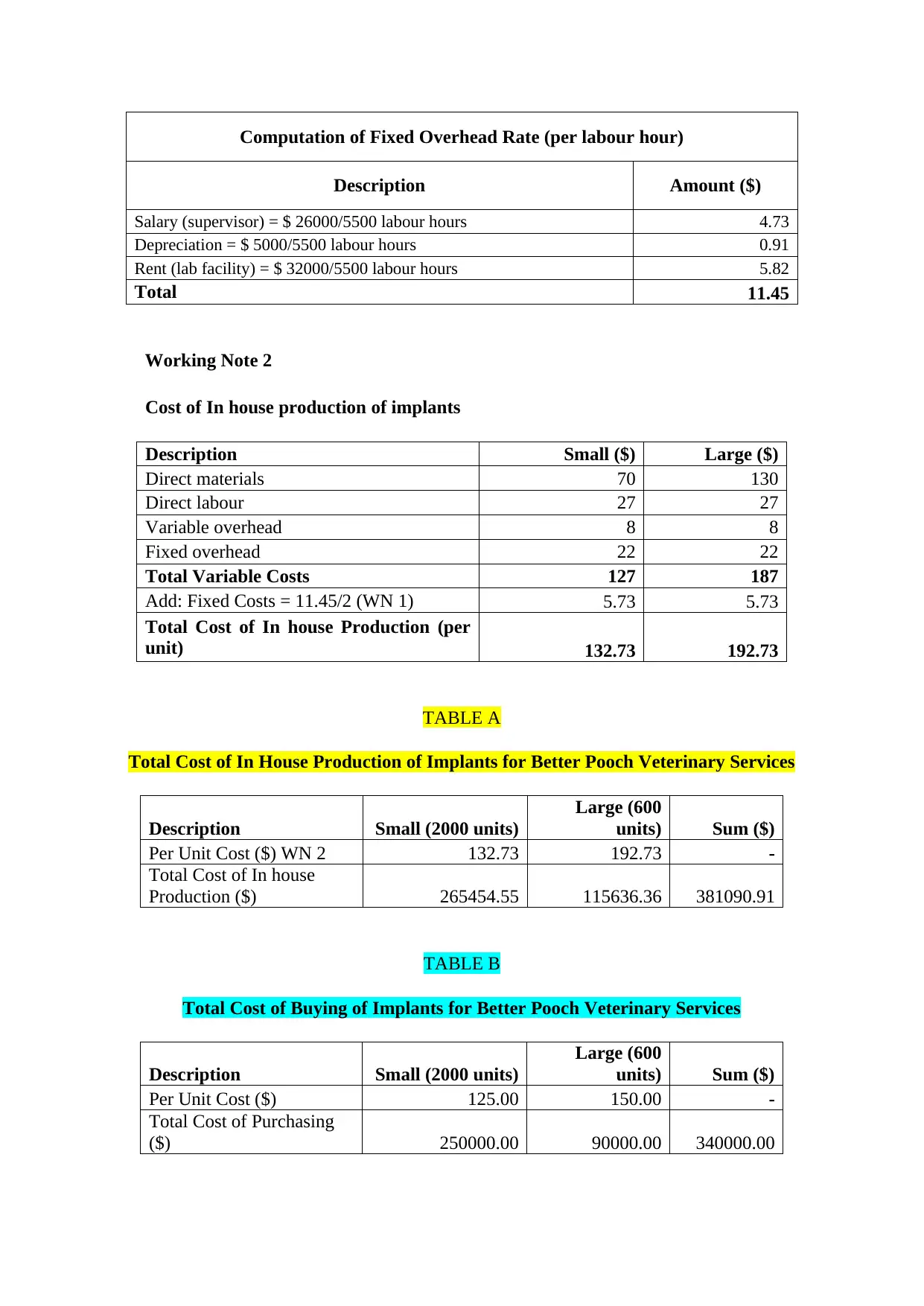
Computation of Fixed Overhead Rate (per labour hour)
Description Amount ($)
Salary (supervisor) = $ 26000/5500 labour hours 4.73
Depreciation = $ 5000/5500 labour hours 0.91
Rent (lab facility) = $ 32000/5500 labour hours 5.82
Total 11.45
Working Note 2
Cost of In house production of implants
Description Small ($) Large ($)
Direct materials 70 130
Direct labour 27 27
Variable overhead 8 8
Fixed overhead 22 22
Total Variable Costs 127 187
Add: Fixed Costs = 11.45/2 (WN 1) 5.73 5.73
Total Cost of In house Production (per
unit) 132.73 192.73
TABLE A
Total Cost of In House Production of Implants for Better Pooch Veterinary Services
Description Small (2000 units)
Large (600
units) Sum ($)
Per Unit Cost ($) WN 2 132.73 192.73 -
Total Cost of In house
Production ($) 265454.55 115636.36 381090.91
TABLE B
Total Cost of Buying of Implants for Better Pooch Veterinary Services
Description Small (2000 units)
Large (600
units) Sum ($)
Per Unit Cost ($) 125.00 150.00 -
Total Cost of Purchasing
($) 250000.00 90000.00 340000.00
Description Amount ($)
Salary (supervisor) = $ 26000/5500 labour hours 4.73
Depreciation = $ 5000/5500 labour hours 0.91
Rent (lab facility) = $ 32000/5500 labour hours 5.82
Total 11.45
Working Note 2
Cost of In house production of implants
Description Small ($) Large ($)
Direct materials 70 130
Direct labour 27 27
Variable overhead 8 8
Fixed overhead 22 22
Total Variable Costs 127 187
Add: Fixed Costs = 11.45/2 (WN 1) 5.73 5.73
Total Cost of In house Production (per
unit) 132.73 192.73
TABLE A
Total Cost of In House Production of Implants for Better Pooch Veterinary Services
Description Small (2000 units)
Large (600
units) Sum ($)
Per Unit Cost ($) WN 2 132.73 192.73 -
Total Cost of In house
Production ($) 265454.55 115636.36 381090.91
TABLE B
Total Cost of Buying of Implants for Better Pooch Veterinary Services
Description Small (2000 units)
Large (600
units) Sum ($)
Per Unit Cost ($) 125.00 150.00 -
Total Cost of Purchasing
($) 250000.00 90000.00 340000.00
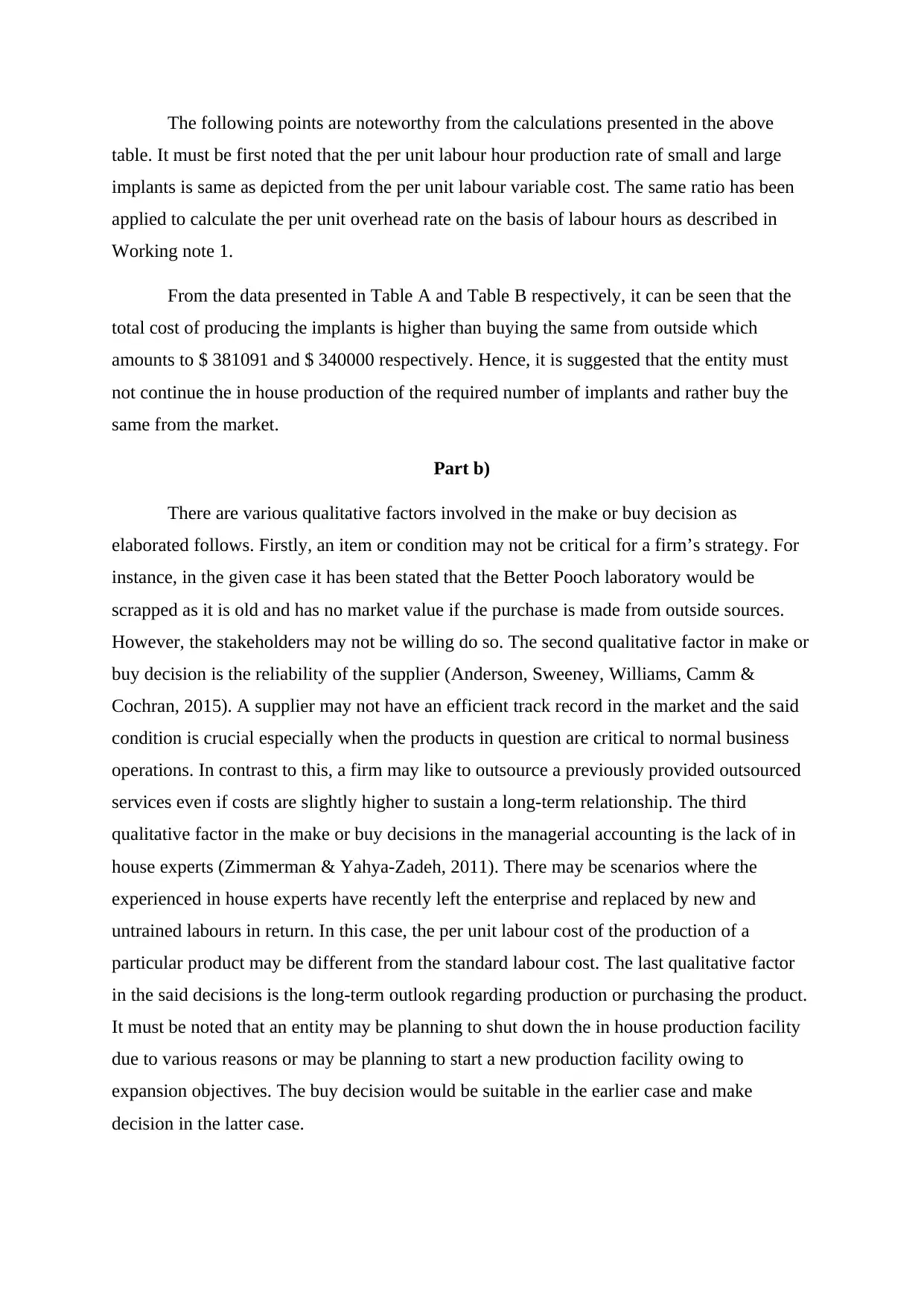
The following points are noteworthy from the calculations presented in the above
table. It must be first noted that the per unit labour hour production rate of small and large
implants is same as depicted from the per unit labour variable cost. The same ratio has been
applied to calculate the per unit overhead rate on the basis of labour hours as described in
Working note 1.
From the data presented in Table A and Table B respectively, it can be seen that the
total cost of producing the implants is higher than buying the same from outside which
amounts to $ 381091 and $ 340000 respectively. Hence, it is suggested that the entity must
not continue the in house production of the required number of implants and rather buy the
same from the market.
Part b)
There are various qualitative factors involved in the make or buy decision as
elaborated follows. Firstly, an item or condition may not be critical for a firm’s strategy. For
instance, in the given case it has been stated that the Better Pooch laboratory would be
scrapped as it is old and has no market value if the purchase is made from outside sources.
However, the stakeholders may not be willing do so. The second qualitative factor in make or
buy decision is the reliability of the supplier (Anderson, Sweeney, Williams, Camm &
Cochran, 2015). A supplier may not have an efficient track record in the market and the said
condition is crucial especially when the products in question are critical to normal business
operations. In contrast to this, a firm may like to outsource a previously provided outsourced
services even if costs are slightly higher to sustain a long-term relationship. The third
qualitative factor in the make or buy decisions in the managerial accounting is the lack of in
house experts (Zimmerman & Yahya-Zadeh, 2011). There may be scenarios where the
experienced in house experts have recently left the enterprise and replaced by new and
untrained labours in return. In this case, the per unit labour cost of the production of a
particular product may be different from the standard labour cost. The last qualitative factor
in the said decisions is the long-term outlook regarding production or purchasing the product.
It must be noted that an entity may be planning to shut down the in house production facility
due to various reasons or may be planning to start a new production facility owing to
expansion objectives. The buy decision would be suitable in the earlier case and make
decision in the latter case.
table. It must be first noted that the per unit labour hour production rate of small and large
implants is same as depicted from the per unit labour variable cost. The same ratio has been
applied to calculate the per unit overhead rate on the basis of labour hours as described in
Working note 1.
From the data presented in Table A and Table B respectively, it can be seen that the
total cost of producing the implants is higher than buying the same from outside which
amounts to $ 381091 and $ 340000 respectively. Hence, it is suggested that the entity must
not continue the in house production of the required number of implants and rather buy the
same from the market.
Part b)
There are various qualitative factors involved in the make or buy decision as
elaborated follows. Firstly, an item or condition may not be critical for a firm’s strategy. For
instance, in the given case it has been stated that the Better Pooch laboratory would be
scrapped as it is old and has no market value if the purchase is made from outside sources.
However, the stakeholders may not be willing do so. The second qualitative factor in make or
buy decision is the reliability of the supplier (Anderson, Sweeney, Williams, Camm &
Cochran, 2015). A supplier may not have an efficient track record in the market and the said
condition is crucial especially when the products in question are critical to normal business
operations. In contrast to this, a firm may like to outsource a previously provided outsourced
services even if costs are slightly higher to sustain a long-term relationship. The third
qualitative factor in the make or buy decisions in the managerial accounting is the lack of in
house experts (Zimmerman & Yahya-Zadeh, 2011). There may be scenarios where the
experienced in house experts have recently left the enterprise and replaced by new and
untrained labours in return. In this case, the per unit labour cost of the production of a
particular product may be different from the standard labour cost. The last qualitative factor
in the said decisions is the long-term outlook regarding production or purchasing the product.
It must be noted that an entity may be planning to shut down the in house production facility
due to various reasons or may be planning to start a new production facility owing to
expansion objectives. The buy decision would be suitable in the earlier case and make
decision in the latter case.
⊘ This is a preview!⊘
Do you want full access?
Subscribe today to unlock all pages.

Trusted by 1+ million students worldwide
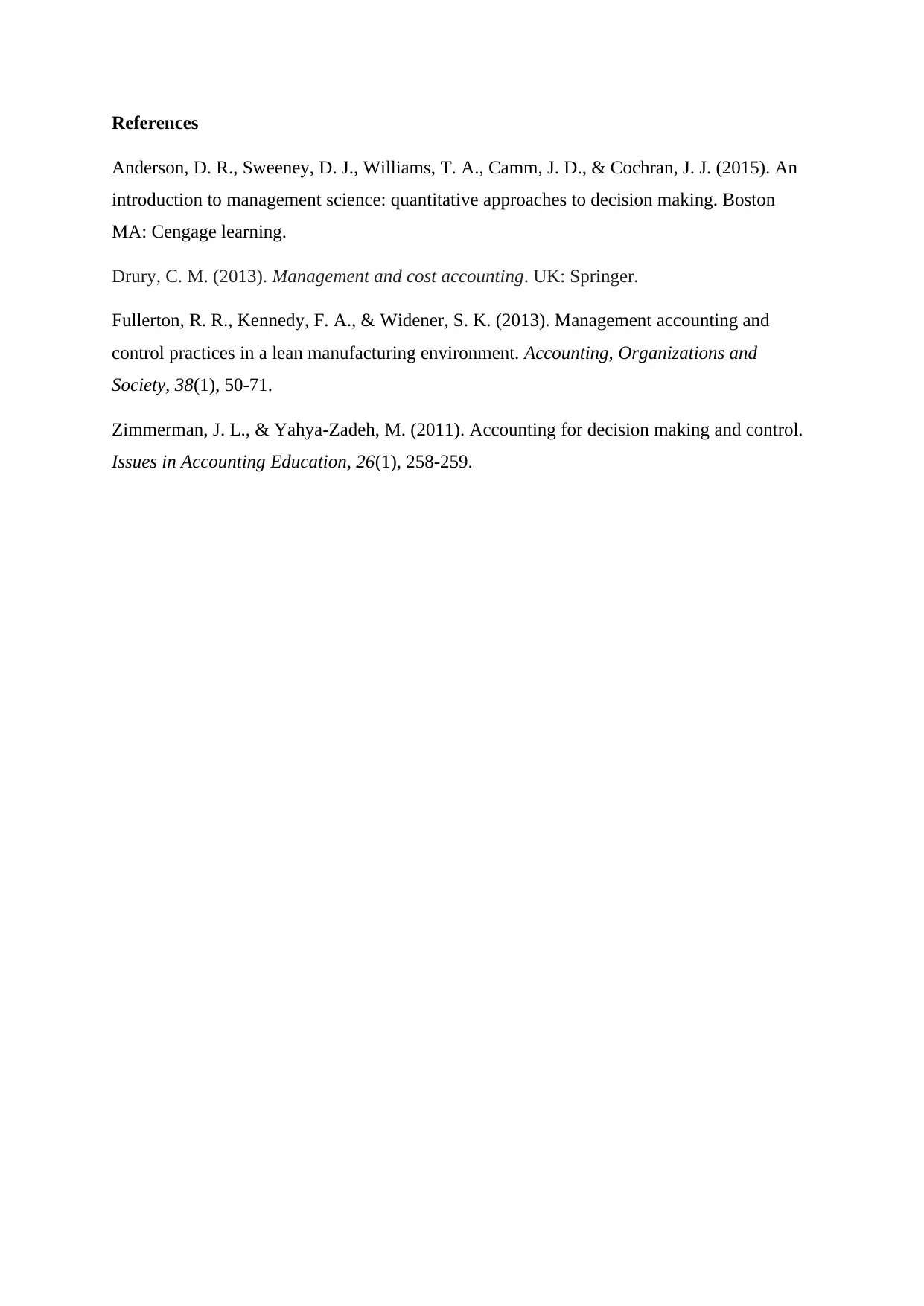
References
Anderson, D. R., Sweeney, D. J., Williams, T. A., Camm, J. D., & Cochran, J. J. (2015). An
introduction to management science: quantitative approaches to decision making. Boston
MA: Cengage learning.
Drury, C. M. (2013). Management and cost accounting. UK: Springer.
Fullerton, R. R., Kennedy, F. A., & Widener, S. K. (2013). Management accounting and
control practices in a lean manufacturing environment. Accounting, Organizations and
Society, 38(1), 50-71.
Zimmerman, J. L., & Yahya-Zadeh, M. (2011). Accounting for decision making and control.
Issues in Accounting Education, 26(1), 258-259.
Anderson, D. R., Sweeney, D. J., Williams, T. A., Camm, J. D., & Cochran, J. J. (2015). An
introduction to management science: quantitative approaches to decision making. Boston
MA: Cengage learning.
Drury, C. M. (2013). Management and cost accounting. UK: Springer.
Fullerton, R. R., Kennedy, F. A., & Widener, S. K. (2013). Management accounting and
control practices in a lean manufacturing environment. Accounting, Organizations and
Society, 38(1), 50-71.
Zimmerman, J. L., & Yahya-Zadeh, M. (2011). Accounting for decision making and control.
Issues in Accounting Education, 26(1), 258-259.
1 out of 7
Your All-in-One AI-Powered Toolkit for Academic Success.
+13062052269
info@desklib.com
Available 24*7 on WhatsApp / Email
![[object Object]](/_next/static/media/star-bottom.7253800d.svg)
Unlock your academic potential
Copyright © 2020–2025 A2Z Services. All Rights Reserved. Developed and managed by ZUCOL.